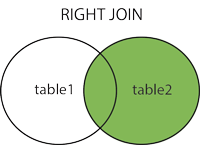Leetcode | SQL
来源:互联网 发布:泰坦军团 显示器 知乎 编辑:程序博客网 时间:2024/06/04 18:02
- Problems
- Basic
- JOIN
- Rank
- Basic knowledge
- Links
- SELECT - extracts data from a database
- UPDATE - updates data in a database
- DELETE - deletes data from a database
- INSERT INTO - inserts new data into a database
- ALIASE - give a table or a column in a table a temporary name
- JOIN - combine rows from two or more tables based on a related column between them
- Operators
- Comments
- DATABASE
- TABLE
- Problems
Problems
Basic
182. Duplicate Emails
SELECT DISTINCT EmailFROM PersonGROUP BY EmailHAVING COUNT(*) > 1;183. Customers Who Never Order
SELECT c.Name AS CustomersFROM Customers AS cWHERE c.Id NOT IN( SELECT CustomerId FROM Orders);184. Department Highest Salary
SELECT d.Name AS Department, e.Name AS Employee, e.Salary FROM Employee e, Department dWHERE e.DepartmentId = d.Id AND e.Salary = ( SELECT MAx(Salary) FROM Employee e2 WHERE e2.DepartmentId = d.Id);196. Delete Duplicate Emails
DELETE p1FROM Person p1, Person p2WHERE p1.Email = p2.Email AND p1.Id > p2.Id;197. Rising Temperature
SELECT w1.IdFROM Weather w1, Weather w2WHERE TO_DAYS(w1.Date) = TO_DAYS(w2.Date)+1 AND w1.Temperature > w2.Temperature;JOIN
175. Combine Two Tables
SELECT p.FirstName, P.LastName, A.City, A.SateFrom Perosn P LEFT JOIN Address AON P.PersonID = A.PersonId;181. Employees Earning More Than Their Managers
SELECT a.Name AS EmployeeFROM Employee a JOIN Employee bON a.ManagerId = b.IdWHERE a.Salary > b.Salary;Rank
176. Second Highest Salary
SELECT Max(Salary) AS SecondHighestSalaryFROM EmployeeWHERE Salary < (SELECT Max(Salary) FROM Employee)177. Nth Highest Salary
CREATE FUNCTION getNthHighestSalary(N INT) RETURNS INTBEGINDECLARE M INT;SET M=N-1; RETURN ( # Write your MySQL query statement below. SELECT DISTINCT Salary FROM Employee ORDER BY Salary DESC LIMIT M, 1 );END178. Rank Scores
# Write your MySQL query statement belowSELECT Scores.Score, COUNT(Ranking.Score) AS RankFROM Scores, ( SELECT DISTINCT Score FROM Scores) RankingWHERE Scores.Score <= Ranking.ScoreGROUP BY Scores.Id, Scores.ScoreORDER BY Scores.Score DESC;-- If only group by Score, same score will be combined180. Consecutive Numbers
SELECT DISTINCT l1.Num as ConsecutiveNums FROM Logs l1, Logs l2, Logs l3WHERE l1.Id=l2.Id-1 AND l2.Id=l3.Id-1 AND l1.Num=l2.Num AND l2.Num=l3.Num-- using user-defined variablesSELECT DISTINCT Num as ConsecutiveNums FROM( SELECT Num, @count := if (@prev = Num, @count+1, 1) count, @prev := Num prev FROM Logs, ( SELECT @count:=0, @prev:=(SELECT Num FROM Logs LIMIT 1) )tmp1 )tmp2WHERE tmp2.count>=3;185. Department Top Three Salaries
SELECT d.Name AS Department, e.Name AS Employee, e.Salary AS Salary FROM Employee e, Department dWHERE ( SELECT COUNT(distinct(Salary)) FROM Employee WHERE DepartmentId = e.DepartmentId AND Salary > e.Salary) in (0,1,2)AND e.DepartmentId = d.IdORDER BY e.DepartmentId, E.Salary DESC;Basic knowledge
Links
- SQL Tutorial
- SQLCourse
- SQLCourses
SELECT - extracts data from a database
SELECT column1, column2, ...FROM table_nameWHERE condition;# Search for a patternNOT LIKE or LIKE '%s%'# NOT starting with "b", "s", or "p"LIKE '[!bsp]%'# Starts with "a" & at least 3 characters in lengthLIKE 'a_%_%'# Between an inclusive rangecolumn_name BETWEEN value1 AND value2or NOT BETWEENe.g. WHERE OrderDate BETWEEN #07/04/1996# AND #07/09/1996#;# To specify multiple possible values for a columncolumn_name IN (value1,value2,...) or IN (SELECT STATEMENT)<> or !==,...AND, OR, NOTIS NULL or IS NOT NULL# [] = optionalORDER BY column1, column2, ... [ASC|DESC];# return only distinct (different) values.SELECT DISTINCT Country FROM Customers;!NOTE: COUNT(DISTINCT column_name) is not supported in Microsoft Access databases.SELECT COUNT(DISTINCT Country) FROM Customers;SELECT Count(*) AS DistinctCountriesFROM (SELECT DISTINCT Country FROM Customers);# SQL Server / MS Access Syntax:SELECT TOP number|percent column_name(s)FROM table_nameWHERE condition;e.g. SELECT TOP 3 or SELECT TOP 50 PERCENT # MySQL Syntax:SELECT column_name(s)FROM table_nameWHERE conditionLIMIT number;# Oracle Syntax:SELECT column_name(s)FROM table_nameWHERE ROWNUM <= number;MIN(), MAX(), COUNT(), AVG(), SUM()UPDATE - updates data in a database
UPDATE table_nameSET column1 = value1, column2 = value2, ...WHERE condition;# can write column1 = column1 + 1# If you omit the WHERE clause, ALL records will be updated!DELETE - deletes data from a database
DELETE FROM table_nameWHERE condition;# If you omit the WHERE clause, all records in the table will be deleted!DELETE [*] FROM table_name;INSERT INTO - inserts new data into a database
# If only insert in specified columns, others = nullINSERT INTO table_name [(column1, column2, column3, ...)]VALUES (value1, value2, value3, ...);ALIASE - give a table, or a column in a table, a temporary name
1. SELECT column_name AS alias_nameFROM table_name;# It requires double quotation marks or square brackets if the alias name contains spaces.[Contact Person]# Combine columnse.g. SELECT CustomerName, Address + ', ' + PostalCode + ' ' + City + ', ' + Country AS AddressFROM Customers;# But in MySQLSELECT CustomerName, CONCAT(Address,', ',PostalCode,', ',City,', ',Country) AS AddressFROM Customers;2.SELECT column_name(s)FROM table_name AS alias_name;e.g.SELECT Orders.OrderID, Orders.OrderDate, Customers.CustomerNameFROM Customers, OrdersWHERE Customers.CustomerName="Around the Horn" AND Customers.CustomerID=Orders.CustomerID;=>SELECT o.OrderID, o.OrderDate, c.CustomerNameFROM Customers AS c, Orders AS oWHERE c.CustomerName="Around the Horn" AND c.CustomerID=o.CustomerID;JOIN - combine rows from two or more tables, based on a related column between them
SELECT Orders.OrderID, Customers.CustomerName, Orders.OrderDateFROM OrdersINNER JOIN Customers ON Orders.CustomerID=Customers.CustomerID;# Join three TablesSELECT Orders.OrderID, Customers.CustomerName, Shippers.ShipperNameFROM ((OrdersINNER JOIN Customers ON Orders.CustomerID = Customers.CustomerID)INNER JOIN Shippers ON Orders.ShipperID = Shippers.ShipperID);# Self JOINe.g.SELECT A.CustomerName AS CustomerName1, B.CustomerName AS CustomerName2, A.CityFROM Customers A, Customers BWHERE A.CustomerID <> B.CustomerIDAND A.City = B.City ORDER BY A.City;



-GROUP BY statement - used with aggregate functions (COUNT, MAX, MIN, SUM, AVG) to group the result-set by one or more columns.
SELECT COUNT(CustomerID), CountryFROM CustomersGROUP BY Country;Operators
UNION, UNION ALL with duplicate valuesHAVING, EXISTS, WHERE column_name operator ANY/ALL (SELECT column_name FROM table_name WHERE condition)Comments
-- Single line/*Multi-line*/DATABASE
- CREATE DATABASE - creates a new database
- DROP DATABASE - drop an existing SQL database
- ALTER DATABASE - modifies a database
TABLE
- CREATE TABLE - creates a new table
CREATE TABLE table_name ( column1 datatype, column2 datatype, column3 datatype, ....);CREATE TABLE new_table_name AS SELECT column1, column2,... FROM existing_table_name WHERE ....;- DROP TABLE - deletes a table
- ALTER TABLE - modifies a table
ALTER TABLE table_nameADD column_name datatype;ALTER TABLE table_nameDROP COLUMN column_name;# ALTER/MODIFY COLUMN# SQL Server / MS Access:ALTER TABLE table_nameALTER COLUMN column_name datatype;# My SQL / Oracle (prior version 10G):ALTER TABLE table_nameMODIFY COLUMN column_name datatype;# Oracle 10G and later:ALTER TABLE table_nameMODIFY column_name datatype;- CREATE INDEX - creates an index (search key)
- DROP INDEX - deletes an index
- …
阅读全文
0 0
- Leetcode | SQL
- Duplicate Emails Leetcode SQL
- [LeetCode] Consecutive Numbers - SQL
- [LeetCode] Rank Scores - SQL
- Leetcode sql算法题
- leetcode-SQL(1)
- Leetcode no. 181 (sql)
- 【leetcode】sql练习
- [leetcode][SQL]ALL
- SQL-LeetCode-easy-595
- LeetCode SQL刷题全解
- Leetcode SQL题
- 【leetcode SQL】Combine Two Tables
- 【leetcode SQL】Second Highest Salary
- leetcode rising Temperature SQL语句
- [leetcode][SQL]182. Duplicate Emails
- sql leetcode 627. Swap Salary
- sql leetcode 182. Duplicate Emails
- 关于python中collections包下的常用功能的使用
- win10 R语言安装rJava包 及 安装jdk环境配置
- Ubuntu16.04安装NVIDIA驱动时的一些坑与解决方案
- C++不同于C的主要细节
- fatal error C1083: 无法打开包括文件:“afxcontrolbars.h”: No such file or directory
- Leetcode | SQL
- python使用问题 "The pandas.io.data module is moved to a separate package "
- 2.XML语言
- opencv网站
- 文章标题
- 许知远:最伟大的世界并不是最嘈杂的时候,而是我们最寂静的时刻
- Uber宣布着手规划空中的士交通系统,我们可以考虑这些事情了
- 群雄逐鹿,谁是未来商业的新主流? | 36氪WISE新商业大会榜单评选正式启动
- 创业者对商业行为合法性有疑问?来看看《反不正当竞争法》的十个问答


